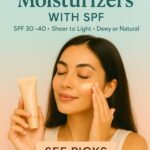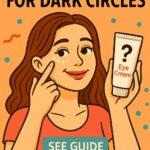
Microneedling creates controlled micro-channels in the very top layers of skin that can improve the look of texture, fine lines, and old marks over time. At home you should stay in the cosmetic range (≤ 0.5 mm on the face) and focus on patience, hygiene, and gentle aftercare. The four tools below include easy rollers, a stamp for targeted spots, and a popular adjustable pen for experienced users who want more control.
Use this guide as practical education, not medical advice. If you have inflammatory acne, eczema, active infections, are on blood thinners, or are pregnant, skip microneedling and speak with a professional first.
Quick Picks
| Tool | Type & Needle Length | Why it’s great | Best for |
|---|---|---|---|
| BeautyBio GloPRO Microneedling Regeneration Tool | Roller, ~0.3 mm, with vibration + red LED | The most polished consumer device; smooth glide and easy routine habit | Beginners who want a premium, low-hassle device |
| Sdara Skincare Derma Roller 0.25 mm | Roller, 0.25 mm | Affordable, widely loved starter roller; encourages product absorption with minimal sting | Budgets, first-timers, monthly maintenance |
| ROSELYN BOUTIQUE Derma Roller 0.3 mm (540) | Manual roller, 0.3 mm | No-frills, very low cost, easy to replace frequently to keep needles sharp | First-time users and anyone who wants frequent head refreshes |
| Sergand Microneedling Pen (Adjustable) | Electric pen, 0.25–2.0 mm (use ≤0.5 mm face at home) | Even vertical channels, adjustable depth/speed, sterile cartridges included | Experienced users who want precision and faster coverage |
Deep dives
BeautyBio GloPRO Microneedling Regeneration Tool — Premium, consistent, beginner-friendly
Rating: 4.7/5
Why it works: A cosmetic-depth roller (~0.3 mm) paired with gentle vibration and red LED makes sessions more comfortable and helps you stay consistent. Reviewers praise the smooth wheel, minimal snagging, and the fact that replacement heads are easy to snap in. The red LED is a nice “habit cue,” though the cosmetic needling itself does the heavy lifting.
Best for: New users who want a polished, low-friction routine and like a brand with clear instructions.
Pros: Quality build, comfortable glide, easy to sanitize and store.
Cons: Pricey head refills; depth is fixed (not for those seeking stronger sessions).
Sdara Skincare Derma Roller 0.25 mm — Budget workhorse that just works
Rating: 4.6/5
Why it works: 0.25 mm is the sweet spot for at-home beginners—light sting, lower risk, and suitable for 1–2× weekly use for product absorption and gradual texture improvement. The Sdara head has 192 fine needles that roll evenly when you keep pressure light and passes minimal. Thousands of owners note better glow and makeup laydown after a month of consistent use.
Best for: Tight budgets, first-timers, or anyone maintaining between occasional pro treatments.
Pros: Very affordable, easy to replace, predictable.
Cons: As with all rollers, you must mind angle/pressure to avoid scratches—slow, short strokes only.
ROSELYN BOUTIQUE Derma Roller 0.3 mm (540) — Ultra-budget, easy to replace often
Rating: 4.4/5
Why it works: A simple 0.3 mm, 540-needle roller that owners like for its low price and consistent availability, which makes it painless to swap for a fresh head every 8–12 uses. That matters because dull or bent needles are the fastest way to irritate skin. At 0.3 mm, you stay in the cosmetic range—good for 1–2× weekly glow, better product laydown, and gradual texture improvement with less sting than longer needles.
Best for: First-timers, budgets, and anyone who prefers replacing a roller head frequently rather than maintaining pricier devices.
How to use: Disinfect the head (70% isopropyl, 5–10 min), pat dry. Work in small sections with light, single-direction passes (6–8 per section), lift, rotate direction, repeat. Follow with a bland hydrator; avoid actives for 24–48 hours.
Pros: Very affordable, easy to keep fresh, widely available colors/variants.
Cons: Basic build; as with all rollers, you must keep pressure feather-light to avoid drag. Not for deeper texture work.
Sergand Microneedling Pen (Adjustable) — Vertical, even channels with cartridge hygiene
Rating: 4.5/5
Why it works: This cartridge-based electric pen creates vertical micro-channels with adjustable depth and speed, which many users find more uniform than rollers on curved areas (nose/cheeks). The kit typically includes multiple sterile, single-use cartridges, and owners highlight smoother passes with less drag plus efficient coverage. For home facial use, keep depth ≤0.5 mm (forehead often 0.25–0.3 mm).
Best for: Confident home users who want precision and repeatable results, or those maintaining between occasional pro sessions.
How to use: Cleanse; disinfect skin; insert a new sterile cartridge. Set depth ≤0.5 mm for face. Glide with straight, overlapping passes and light pressure—no “scribbling.” Post-care stays simple (hyaluronic serum, bland moisturizer); no retinoids, acids, or vitamin C for 24–72 hours.
Pros: Customizable depth/speed, consistent vertical entry, cartridge hygiene, faster than manual tools.
Cons: Learning curve; ongoing cartridge cost; strict sanitation is non-negotiable.
Safe technique (read this part)
- Depth: Stay ≤0.5 mm for face at home. Avoid eyelids and active breakouts.
- Frequency:
- 0.25–0.3 mm: 1–2× weekly
- 0.5 mm: every 2–4 weeks
- Prep: Cleanse, dry completely, tie hair back, sanitize tool with 70%+ isopropyl alcohol for 5–10 minutes, then air-dry.
- Method: Work in small sections. Use light pressure; roll or stamp in one direction (up to 6–8 passes per section), lift, then change direction. Do not saw back and forth.
- Aftercare: Apply a simple, fragrance-free hydrator (hyaluronic serum, bland moisturizer). No actives (retinoids, acids, vitamin C, benzoyl peroxide) for 24–72 hours depending on your skin.
- Hygiene: Never share devices. Replace roller heads every 10–15 uses; discard dull or bent needles.
- Hard stops: Active acne, dermatitis/eczema, keloid tendency, recent peels/lasers, blood-thinning meds, pregnancy—consult a clinician or skip.
See also
To support barrier recovery and glow between sessions, start with Best Niacinamide Serums for redness and pore look, then rotate in gentle brightening from Best Vitamin C Serums once skin is calm. If you want an evening step that pairs well with non-needling nights, our Best Retinol Creams for Beginners shortlists forgiving formulas that smooth with less sting.
Keep the routine soothing around treatment days—cleanse with one of our picks from Best Face Cleansers for Sensitive Skin and don’t forget daily protection from Best Face Sunscreen for Acne-Prone Skin so the gains you make don’t get undone by UV. Those five guides round out a safe, effective home texture plan without overpowering your skin.
FAQ
Roller, stamp, or pen—which is best
Rollers are easiest and cheapest; stamps reduce drag and excel for targeted spots; pens give the most even, vertical channels and customizable depth but require stricter technique and hygiene.
How long until I see results
Most users report smoother makeup laydown and glow in 2–4 weeks with consistent 0.25–0.3 mm sessions; textural changes take 8–12 weeks or more.
Can I use retinol or acids after microneedling
Not right away. Wait 24–72 hours depending on skin sensitivity. Stick to bland hydrators and sunscreen in the meantime.
Does it help hairlines or brows
Some use cosmetic-depth needling along the hairline with a simple niacinamide serum. Avoid broken skin and stop if irritated; discuss any hair-growth actives with a professional.
How do I sanitize correctly
Wash the tool with gentle soap and water after use, rinse, then soak the head in 70% isopropyl alcohol for 5–10 minutes. Air-dry in a clean case. Replace bent/dull heads.
Affiliate Disclosure
If you purchase through links on our site, we may earn a small commission at no extra cost to you.




